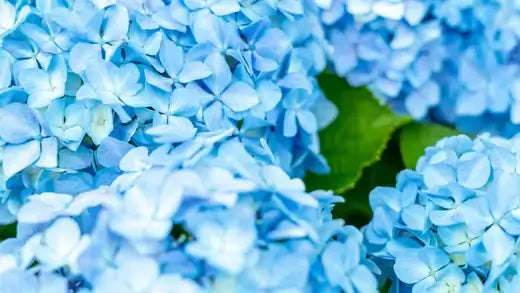Flowering Shrubs
In the vast tapestry of nature's creations, shrubs are intricate threads that weave together beauty, functionality, and ecological significance. These versatile plants come in many forms, colors, and sizes, each possessing unique characteristics that contribute to the ecosystems they inhabit. Among the numerous varieties, the Blue Hydrangea, Snow Hill Hydrangea, Maple Leaf Viburnum, and Arrowhead Viburnum shine as examples of the captivating diversity within the world of shrubs. These plants not only adorn landscapes with their splendor but also play pivotal roles in soil stability, air quality enhancement, and the creation of vital wildlife habitats.
Blue Hydrangea: Majestic Elegance in Blooms
The Blue Hydrangea (Hydrangea macrophylla) symbolizes classic beauty with its large, round flower clusters that vary in color from vibrant blue to soft pink, depending on the soil's acidity levels. Native to Japan, this hydrangea species thrives in partial shade and moist, well-drained soil. Its remarkable ability to change color based on soil pH has made it a favorite among gardeners seeking to create captivating color schemes.
Snow Hill Hydrangea: A Blanket of Floral Serenity
The Snow Hill Hydrangea (Hydrangea arborescens 'Grandiflora') is renowned for its pristine white, globe-shaped blooms that blanket the plant during summer. Originating from North America, this hydrangea species flourishes in various conditions, from full sun to partial shade. Its snow-white flowers add a touch of elegance to gardens and attract pollinators, contributing to the area's biodiversity.
Maple Leaf Viburnum: Nature's Quilted Foliage
The Maple Leaf Viburnum (Viburnum acerifolium) stands out for its dainty clusters of white flowers that transform into vibrant blue-black berries and its unique three-lobed, maple-like leaves. Native to eastern North America, this shrub thrives in the understory of deciduous forests, showcasing its adaptability to various light conditions. Its berries are a bird's food source, and its dense foliage covers small animals.
Arrowhead Viburnum: A Symphony of Textures
The Arrowwood Viburnum (Viburnum dentatum) captures attention with its glossy, deep-green foliage and creamy white, flat-topped flower clusters that give way to bluish-black berries. This shrub, native to North America, thrives in moist habitats, making it a valuable player in riparian ecosystems. Its dense growth and berry production provide sustenance and shelter for various wildlife species, from insects to birds.
Stability Beneath the Surface: Shrubs and Soil Health
One of the often-underappreciated roles of shrubs is their significant contribution to soil stability. With their intricate root systems, shrubs help prevent soil erosion, especially on sloped landscapes and areas prone to heavy rainfall. The root networks of shrubs bind the soil particles together, creating a natural barrier against the destructive forces of water. Moreover, the fallen leaves and organic matter from shrubs enrich the soil, enhancing its nutrient content and structure.
Breathing Easier: Shrubs and Air Quality
Shrubs are silent heroes in the battle for cleaner air. Through photosynthesis, shrubs absorb carbon dioxide and release oxygen, contributing to the overall improvement of air quality. Additionally, their leaves trap airborne pollutants and particulate matter, acting as natural air filters. Air pollution can be a pressing concern in many environments, and the presence of shrubs plays an essential part in alleviating the negative impacts of pollutants on human health.
Wildlife Havens: Shrubs as Habitat Providers
Shrubs are veritable havens for wildlife, creating habitats that support a diverse array of creatures. Their dense foliage provides shelter and nest sites for birds, mammals, and insects. The berries, seeds, and nectar produced by shrubs serve as essential food sources for numerous wildlife species, fostering ecosystem biodiversity. Bees and butterflies are particularly drawn to the blooms of many shrub species, aiding in pollination and ensuring the reproduction of various plants.
Shrubs are the unsung champions of the natural world, offering a symphony of benefits that enrich the environment on multiple levels. The Blue Hydrangea and Snow Hill Hydrangea dazzle with their delicate blooms, while the Maple Leaf Viburnum and Arrowhead Viburnum boast unique foliage and nourishing berries. Beyond their aesthetic appeal, these shrubs contribute to soil stability by preventing erosion and enriching soil health. They also play a vital role in purifying the air, making it healthier for all living beings. Moreover, by creating diverse habitats, shrubs invite many wildlife species to thrive within their branches. As stewards of the Earth, recognizing and appreciating the multifaceted contributions of shrubs can inspire us to incorporate these plants into our landscapes, gardens, and urban spaces. By doing so, we not only enhance the aesthetic beauty of our surroundings but also actively participate in the preservation and enrichment of the delicate balance of nature.



